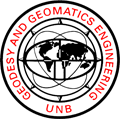What's the Geoid?
The Earth is a sphere, right? Wrong: the geoid is considered by some scholars to represent the real shape of the earth. This is true at sea; on land the shape of the earth is given by the terrain. The relation of the geoid and the terrain is discussed in the following article written by one of our faculty members.
The Geoid
Petr Vaníček
Department of Geodesy and Geomatics Engineering
University of New Brunswick
P.O.Box 4400, Fredericton, N.B. E3B 5A3
Have you ever asked yourself how do we get those 'heights above the sea level' displayed on the maps? It is, perhaps, not so difficult to visualize how this is done close to the sea shore, but how about the inland areas? In the past, heights of inland points were determined by a technique known as levelling, which consists of measuring directly the height differences of points, no more than about 100 metres apart. By starting at the sea shore and adding these height differences up, we would eventually end with the height of any desired inland point. This is a conceptually simple but rather sluggish and expensive process.
Beginning in the late 1960's, we have been using geodetic satellites - satellites designed to give us positions, i.e., coordinates, of points anywhere on the surface of the earth. From these coordinates, we can actually calculate the "heights" ot these points directly. The problem with these "heights" is that they are referred to the centre of the earth rather than the sea level and as such are not of much practical use. Who would be interested in heights ranging between 6,356,086 metres (approximately the height of the sea level at the poles) and 6,378,137 metres (approximately the height of the sea level at the equator)? Parenthetically, if heights were referred to the centre of the earth, Mt. Chimboraso in Equador (with an altitude of 6,272 m and a latitude of 2 degrees south) with its "height" of 6,384,383 metres would be the highest mountain in the world, while Mt. Everest, or Mt. Chomolungua, as the Chinese call it, would be only 6,381,941 metres high.
To transform the "heights" above the centre of the earth to heights above the sea level, we have to know just how far the sea level is from the centre of the earth. But how can we determine this distance, called sometimes the geocentric height, when we are on land, where there is no sea whose level we are supposed to work with? This is where the geoid comes in.
It was the famous German Mathematician, Karl Friedrich Gauss, who, some two hundred years ago, realising that the undisturbed sea level represents one uninterrupted level (horizontal) surface, introduced the idea of extending this surface under the land masses. He named this surface "the geoid" and it is this particular horizontal surface that we have to know in order to transform the geocentric heights to the practical heights above the sea level. Since Gauss's time, geodesists, the rare breed of scientists who are interested, among a few other things, in the geometry of the earth, have been trying to determine this elusive surface with an ever increasing accuracy.
Now, how do we go about determining this horizontal surface, which is, roughly speaking, nothing else but a continuation of the undisturbed sea level, under the continents? It can be determined only indirectly, from various types of measurements on the surface of the earth, by some fairly involved computations. The main kind of data needed to carry out these computations, are observed gravity (the force that keeps us on the earth), heights (from levelling) and mass density (from geological maps). The broadest features of the geoid can be gleaned from observed satellite orbit irregularities, but these broad feature represent the geoid only to an accuracy of some 10 metres or so, and would not be of much use in our transformation problem.
The knowledge of the geoid has turned out to be useful also for all kinds of other applications as well, in disciplines such as oceanography, hydrography, theoretical geophysics, exploration geophysics. Its main application is, however, in surveying as described in the previous paragraphs. This is why, some of us, in the Department of Geodesy and Geomatics Engineering, are intensely interested in determining the geoid in Canada to the highest possible accuracy. In 1986, we computed the first accurate geoid for Canada. Its update, compiled in 1991, was adopted as the Canadian national geoid solution.


